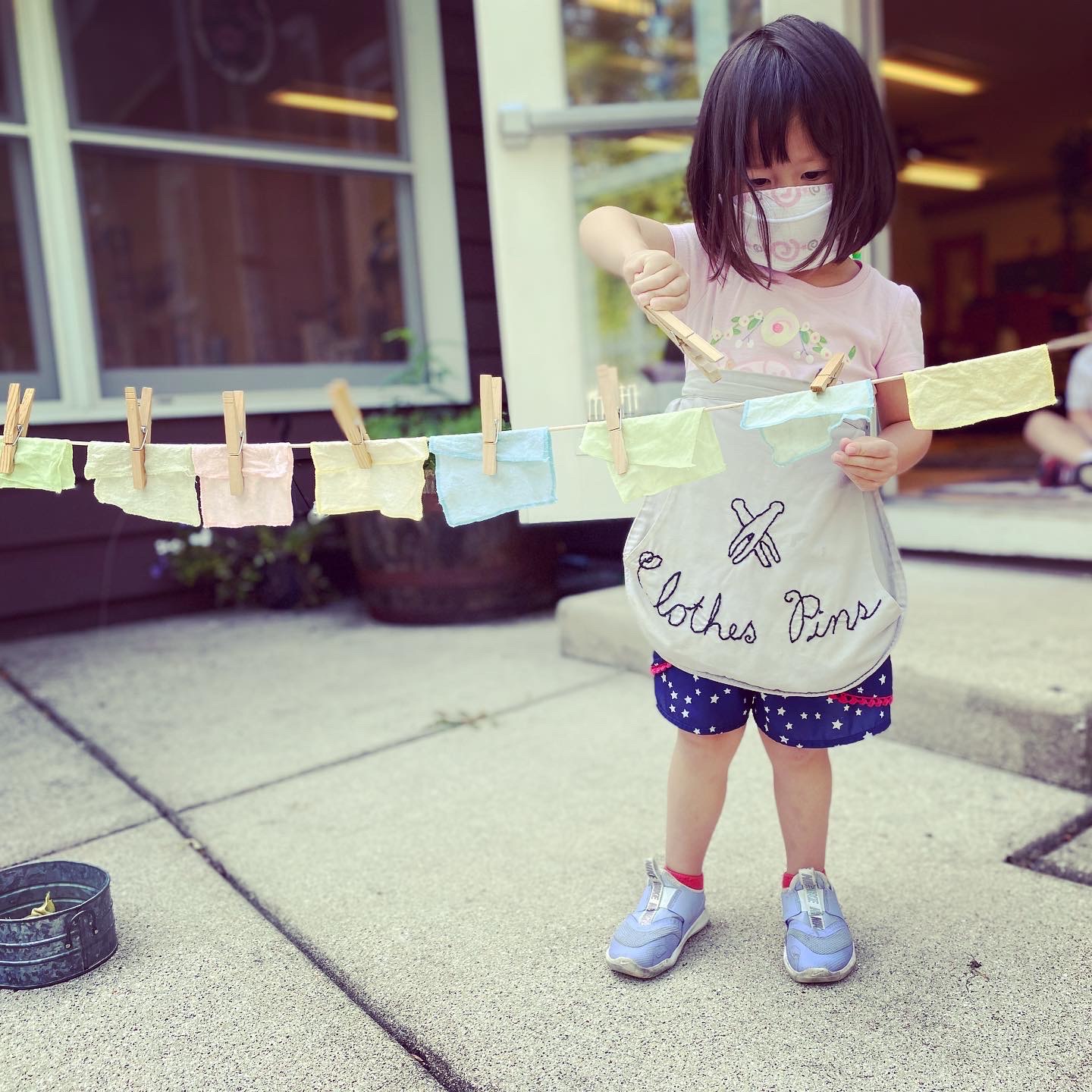“The children of three years of age in the ‘Children’s Houses’ learn and carry out such work as sweeping, dusting, making things tidy, setting the table for meals, waiting at table, washing the dishes, etc., and at the same time, they learn to attend to their own personal needs, to wash themselves, to take showers, to comb their hair, to take a bath, to dress and undress themselves, to hang up their clothes in the wardrobe, or to put them in drawers, to polish their shoes. These exercises are part of the method of education, and do not depend on the social position of the pupils; even in the ‘Children’s Houses’ attended by rich children who are given every kind of assistance at home, and who are accustomed to being surrounded by a crowd of servants, take part in the exercises of practical life. This has a truly educational, not utilitarian purpose. The reaction of the children may be described as a ‘burst of independence’ of all unnecessary assistance that suppresses their activity and prevents them from demonstrating their own capacities. It is just – these ‘independent’ children of ours who learn to write at the age of four and a half years, who learn to read spontaneously, and who amaze everyone by their progress in arithmetic.” Maria Montessori
So often after enrolling in a Montessori school do parents enthusiastically ask, “What can we do at home to support the philosophy?” For some, the assumption is that it will be a quick fix, a small alteration of sorts. But when parents sit down with their child’s teacher for the first time, they often discover that in order to provide their child with the continuity that is necessary, they will have to make fairly grand life-style changes. What they don’t typically understand is that the undertaking will be less about the physical changes to the home environment and more about their philosophical approach. It begins with a basic understanding that we, as adults, are simply “aids” in the development of our children. In the Montessori teachers’ training, the philosophy taught us to see ourselves as observers, always waiting for opportunities to entice the child and to encourage interest. As observers, we are recognizing the child’s natural desire to learn, putting the child in the driver’s seat.
While the Montessori approach is often characterized as “child-centered”, that does not mean that we are catering to every whim or fulfilling each request. It means that we are inspiring our children to become independent in every possible way. In addition, while expecting our children to respect us, we are also respecting their individuality and natural curiosity. We are guiding them in how to do things on their own rather than relying on us to tell them how it’s done. With this independence will come mistakes…lots of them. We must welcome these. Encourage them even. Without these failures, our children have no chance of building resilience. Resisting the impulse to “help” is as good a place to start as any. We must remember to step back as soon as we witness engagement or concentration in an activity. We must also refrain from correcting, praising, or interfering. Interference or too much “help” leads to dependency and as a parent that’s a difficult, often well- intended habit to break free of. Helping a child with a physical task or solving problems for him will inevitably create this dependency. Be wary of it at every age and every stage of development. “Never help a child with a task at which he feels he can succeed.” Maria Montessori
In the Montessori teacher’s training, we learn that the young child will absorb an abundance of information from just our actions as opposed to our words. The idea of showing and not telling is a fundamental part of the Montessori method. The materials at each level are presented with little verbal clarification. This allows the child to focus on what’s important…the activity itself. The words that we do use when presenting a lesson are thoughtfully chosen. Our movement is slow, purposeful, and concise. As parents, we can learn from how these lessons are presented. Slow down and take the time that’s necessary to show our children how to execute a task.
Additionally, “modeling” or teaching your child to think for himself by showing him at every possible opportunity how you make decisions is imperative. Montessori teachers model behaviors every day to demonstrate responsibility, respect, and resourcefulness. They offer new challenges once old ones have been surmounted. Montessori introduced “Grace and Courtesy” exercises in reaction to the young child’s need for order and for an understanding of why we do what we do in social situations. The child has a desire to know and to absorb the social structures in order to be more at ease in his environment, wherever that may be. Grace and Courtesy lessons give the child the vocabulary, actions, and steps required for him to build his awareness and responsiveness of those around him. This, in turn, gives him a better sense of orientation in his social structure.
The primary class (typically ages 3-6) is the perfect place to begin these exercises in Grace and Courtesy because the child at the end of the First Plane of Development is not yet self-conscious. He is willing to try anything new and will then incorporate it more naturally into his person. Grace and Courtesy lessons are presented to every child in the class and usually in a small group, almost a dramatization of sorts. It’s an introduction to simple etiquette such as: giving comfort to a friend, passing by a tight space, ordering food in a restaurant, walking around a conversation, greeting by name, introducing two friends, and giving and receiving a gift to name just a few. This allows the child to have a clear understanding as well as a place to perfect himself with others. It is the teacher’s role to give the children the correct words, precise movements, and steps. In turn, he fully absorbs the how, the when, and the vocabulary used in his environment to make life more comfortable for others and for himself. In the end, the goal of these lessons is to have the child incorporate these graces and courtesies into his everyday life, which will allow for a more pleasant classroom as well as a more gratifying environment wherever the child may go. This practice is why parents of authentic Montessori programs so often receive comments about “how well mannered” their children are.
Through Dr. Montessori’s observations, she came to see that children actually want to become respected members of their small communities…whether it is the family community or the classroom. In order for him to do this, the child needs to learn what is considered appropriate behavior. These Grace and Courtesy lessons are educating our children for LIFE. I’d say, even more important to our society today than ever before.
Remember that with repetition comes mastery. Oftentimes we forget this when it comes to proper behavior and manners. We find ourselves saying to our children, “I just told you to….” The adage “practice what you preach” is partially correct in that we do want to model all that we would expect our children to do, so there is no double standard: “Do as I say, not as I do.” But we want to present rather than preach. These lessons absolutely should be incorporated at home. With these teachings, parents can set the standard of how they want their homes to function. Never assume that the children already know something. Instead, we teach everything, giving the child the opportunity to do it correctly, as they generally want to do. As Montessori said so simply, “The human personality, or the care of it, is broken up. On the one side is the home…on the other side is the school…There is no unity of conception.” It really does start at home, so let’s make it count.
Calls us to schedule your personalized virtual tour.
847-498-1105



Leave a Comment